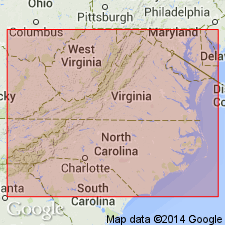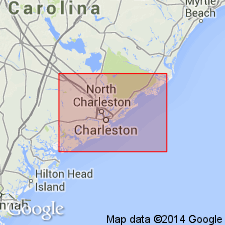
- Usage in publication:
-
- Haywood Landing Member*
- Modifications:
-
- Named
- Dominant lithology:
-
- Sand
- Clay
- AAPG geologic province:
-
- Atlantic Coast basin
Summary:
Named as member of Belgrade Formation (new). Named for a small outcrop (only known natural outcrop) at Haywood Landing on White Oak River, 1.2 km below mouth of Holston Creek, Jones Co., eastern NC. Exposed in borrow pits at Silverdale, and in western wall of Martin Marietta quarry at Belgrade. Occurs in shallow subsurface in Bogue Inlet and New River Inlet areas. Usually consists of unconsolidated gray to brown, moderately phosphatic, locally somewhat calcareous, clayey, very shelly quartz sands. Shells can constitute 50 percent of unit and range from leached to well preserved. In Martin Marietta quarry at Belgrade, sandy shell bed grades upward into laminated olive-green clay. Thickness is approx 3 m at type locality; Brown and others (1972) show sediments of Haywood Landing Member lithology (which they assign to Oligocene) in a core section from southeastern Craven Co. as approx 31 ft thick. Contact relationships seen only in Martin Marietta quarry. Overlies River Bend Formation (new); underlies sediments equivalent to Duplin Formation. Offshore equivalent of Pollocksville Member (new) of Belgrade Formation. Assigned an early Miocene age. Report includes geologic sketch map, correlation chart, columnar section, and detailed descriptions of type and reference localities.
Source: GNU records (USGS DDS-6; Reston GNULEX).

- Usage in publication:
-
- Haywood Landing Member
- Modifications:
-
- Age modified
- AAPG geologic province:
-
- Atlantic Coast basin
Summary:
On the basis of its correlation with the Old Church Formation, Belgrade Formation and its Haywood Landing and Pollocksville Members are Oligocene and early Miocene.
Source: GNU records (USGS DDS-6; Reston GNULEX).

- Usage in publication:
-
- Haywood Landing Member
- Modifications:
-
- Not used
- Overview
- AAPG geologic province:
-
- Atlantic Coast basin
Summary:
Oligocene and lower Miocene stratigraphic nomenclature in NC was revised almost simultaneously by Baum and others (1978) and Ward and others (1978). According to authors, recent studies indicate that neither interpretation is accurate and further revision is necessary. The interpretation presented here is based on a combination of the earlier revisions. At their type localities, the Haywood Landing Member of Ward and others, and the Silverdale Formation (used here) of Baum and others contain calcareous nannofossils of Zones NP24-25 (late Oligocene), while the type section of the Belgrade Formation of Ward and others and the type section of their Pollocksville Member are early Miocene in age. The late Oligocene Belgrade (inshore) and Silverdale (offshore) Formations of Baum and others are used in this report. The overlying early Miocene Pollocksville is reduced in status to informal Pollocksville beds. The Haywood Landing Member of Ward and others is not used.
Source: GNU records (USGS DDS-6; Reston GNULEX).
For more information, please contact Nancy Stamm, Geologic Names Committee Secretary.
Asterisk (*) indicates published by U.S. Geological Survey authors.
"No current usage" (†) implies that a name has been abandoned or has fallen into disuse. Former usage and, if known, replacement name given in parentheses ( ).
Slash (/) indicates name conflicts with nomenclatural guidelines (CSN, 1933; ACSN, 1961, 1970; NACSN, 1983, 2005, 2021). May be explained within brackets ([ ]).

